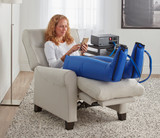Compression Therapy For Treatment Of Lymphedema, Venous Insufficiency And Wound Healing
Compression Therapy For Treatment Of Lymphedema, Venous Insufficiency And Wound Healing
Although Lymphedema has afflicted the population for centuries, little
was understood about the disease. Only in the past ten to fifteen years
have clinicians begun to seriously focus on its treatment.
Lymphedema is an accumulation of lymphatic fluid that causes swelling in
the arms and legs. Edema occurs when venous and/or lymphatic vessels
are impaired. When the impairment is so great that the lymph fluid
exceeds the lymphatic transport capacity, an abnormal amount of protein
fluid collects in the tissues of the extremity. Untreated, this
stagnant, protein-rich fluid not only causes tissue channels to increase
in size and number, but also reduces oxygen through the transport
system, interferes with wound healing and provides a culture medium for
bacteria that can result in various infections.
Lymphedema can
occur from idiopathic or unknown causes. This is called Primary
Lymphedema. Lymphedema can be present at birth, either idiopathically or
associated with arterial-venous abnormalities, hemangioma, or
lymphangioma. Breast or abdominal surgery can result in Secondary
Lymphedema. Surgical removal of a tumor and the adjacent lymph nodes and
vessels can block lymph fluid from flowing naturally through its
system. Other surgeries that require lymph node removal are those
performed for skin cancer (melanoma), gynecological cancers, bladder or
colon cancer and prostate or testicular cancer.
Radiation
therapy used in the treatments of various cancers and some AIDS-related
diseases, can damage otherwise healthy lymph nodes by causing scar
tissue to form and thus, interrupt the normal pathway of the lymphatic
fluid.
Lymphedema can occur secondary to an infection that
interrupts normal lymphatic pathway function. A severe traumatic injury
may also trigger the onset of lymphedema.
According to the
World Health Organization, lymphedema affects 250 million people
worldwide. Others estimate that one in every twenty-five will suffer
from some form of lymphedema during their lifetime. The M.D. Anderson
Hospital in Houston, Texas reports that approximately 15% of all women
with breast cancer will develop lymphedema over the course of their
lifetime and that lymphedema resulting from prostate cancer is on the
rise.
Lymphedema is a chronic condition and often begins with a
swelling in the hands or feet. Early diagnosis and treatment improves
both the prognosis and the condition. Left untreated, the limbs become
more edematous and the skin hardens, losing its elasticity (fibrosis).
Moreover, untreated lymphedema leads to infection and sometimes,
irreversible complications. Compression must be applied to the limb to
reduce the swelling. Surgical compression stockings or sleeves can apply
compression. Manual Lymph Drainage (MLD) is performed by specially
trained therapists, utilizing a gentle massaging technique in
conjunction with a pumping motion. Some treatment centers use a special
bandaging technique.
Increasingly, compression pumps are being
used to treat lymphedema. The system consists of a pump and an appliance
(sleeve) which fits over the extremity. Air pressure is applied to the
appliance which in turn, applies pressure to the extremity. The basic
pump applies a uniform pressure over the extremity. The better devices
consist of a pump and appliance with three or more segment which
sequentially apply pressure along the extremity, distally to proximally.
Since lymphatic pressure is greater distally than proximally, the
preferred method of compression therapy would be to mimic the lymphatic
system. This is accomplished by means of a pump that applies gradient
pressure to the segmented appliance. This system mimics the lymphatic
system wherein it applies gradual, gradient pressure distally to
proximally, moving the accumulated fluid from the affected extremities
back into the body where it can be naturally eliminated. It simulates a
gentle massaging action. Pressure and the subsequent effectiveness can
be gradually increased as the patient becomes more tolerant. These
devices are low cost, lightweight, quiet, comfortable and easy to use
for home therapy. Because of its comfort and ease of use, compliance is
very high. It is the cost-effective way to treat lymphedema and venous
insufficiency. Compression therapy additionally, is extremely effective
in curing decubitus ulcers and the lower of the extremities.
Recent Posts
-
Lymphedema Sequential Pump Management
Patients living with Lymphedema find the condition can be very difficult at times both physically an …Feb 8th 2019 -
Lymphedema Treatment
Lymphedema is the result of fluid accumulation in a blocked lymph channel causing pain and swellin …Jul 25th 2016 -
Stanford University Study on Lymphedema
Falk Cardiovascular Research Center Stanford University School of Medicine 300 Pasteur Drive Stanfor …Jul 25th 2016
